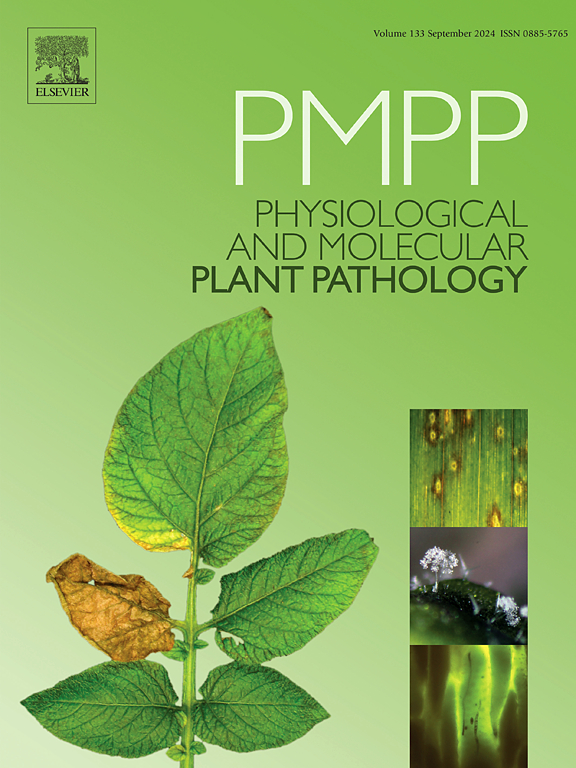通过生化和分子筛选分析谷草镰刀菌对苯唑类杀菌剂的敏感性和寄主反应
IF 2.8
3区 农林科学
Q2 PLANT SCIENCES
引用次数: 0
摘要
稻谷镰刀菌是造成粮食作物枯萎病的主要病原菌。本研究旨在利用拟南芥(Arabidopsis thaliana-F.)鉴定抗替布康唑和敏感的禾本科F. graminearum菌株及其寄主反应。通过生化和基因表达研究禾本科相互作用。从fhb感染的小麦穗中分离到的32株真菌经分子和系统发育分析证实为禾谷镰刀菌成员。选用对照菌株Z-3639测定有效浓度(EC50)为2.5 ppm时,筛选32株菌株对戊康唑的敏感性。根据生长抑制率将真菌分为5株高耐药(HR)、7株耐药(R)、11株敏感(S)和9株高敏感(HS)。对8株菌株(每组2株)的替布康唑效果进行评估,结果显示菌丝体和分生孢子出现不同程度的畸形。两株菌株TN1-3 (HR)和TN3-4 (HS)以及对照菌株对替布康唑反应基因的表达进行了检测,与杀菌剂处理的HS菌株和对照相比,HR菌株的cyp51a表达上调,表明其是潜在的真菌靶点。用DAB(3,3′-二氨基联苯胺)染色分析杀菌剂处理的HR和HS菌株的活性氧(ROS)积累,结果显示,与未处理替布康唑的HR和HS菌株相比,杀菌剂处理的植株的活性氧积累较少,表明杀菌剂处理降低了真菌毒力。同样,叶绿素估算、超氧化物歧化酶(SOD)和过氧化氢酶测定等生化反应也与植物防御基因表达相关,这些结果都与杀菌剂处理过的禾草赤霉病菌株的防御活性有关。本文章由计算机程序翻译,如有差异,请以英文原文为准。

Analyzing Fusarium graminearum strains for sensitivity to Tebuconazole fungicide and host responses by biochemical and molecular screening
Fusarium graminearum is the chief causal agent of Fusarium head blight (FHB) disease in cereal crops. The study aimed at identifying Tebuconazole-resistant and sensitive F. graminearum strains and host responses using Arabidopsis thaliana-F. graminearum interaction through biochemical and gene expression studies. Thirty-two fungal isolates isolated from FHB-infected wheat spikes were confirmed as F. graminearum members by molecular and phylogenetic analyses. All 32 strains were screened for sensitivity to Tebuconazole at the effective concentration (EC50) of 2.5 ppm, determined using the control strain, Z-3639. Based on percent growth inhibition, the fungal strains were grouped into 5 highly resistant (HR), 7 resistant (R), 11 sensitive (S) and 9 highly sensitive (HS) strains. Assessing Tebuconazole effect on 8 strains, representing 2 from each group showed varying levels of mycelial and conidial malformation. Two strains– TN1-3 (HR) and TN3-4 (HS) and the control strain tested for the expression of Tebuconazole-responsive gene, CYP-51A showed up-regulation in fungicide-treated HR strain compared to fungicide-treated HS strain and the controls indicating it as the potential fungal target. Analysis of reactive oxygen species (ROS) accumulation by DAB (3,3′-diaminobenzidine) staining in plants challenged with fungicide treated HR and HS strains showed lesser accumulation compared to the plants challenged with Tebuconazole-untreated HR and HS strains revealing reduced fungal virulence due to fungicide treatment. Similarly the biochemical responses in terms of chlorophyll estimation, superoxide dismutase (SOD) and catalase assays also correlated with the defense gene expression in plants challenged with fungicide–treated F. graminearum strains highlighting defense activation against F. graminearum and the results are presented.
求助全文
通过发布文献求助,成功后即可免费获取论文全文。
去求助
来源期刊
CiteScore
4.30
自引率
7.40%
发文量
130
审稿时长
38 days
期刊介绍:
Physiological and Molecular Plant Pathology provides an International forum for original research papers, reviews, and commentaries on all aspects of the molecular biology, biochemistry, physiology, histology and cytology, genetics and evolution of plant-microbe interactions.
Papers on all kinds of infective pathogen, including viruses, prokaryotes, fungi, and nematodes, as well as mutualistic organisms such as Rhizobium and mycorrhyzal fungi, are acceptable as long as they have a bearing on the interaction between pathogen and plant.

 求助内容:
求助内容: 应助结果提醒方式:
应助结果提醒方式:


